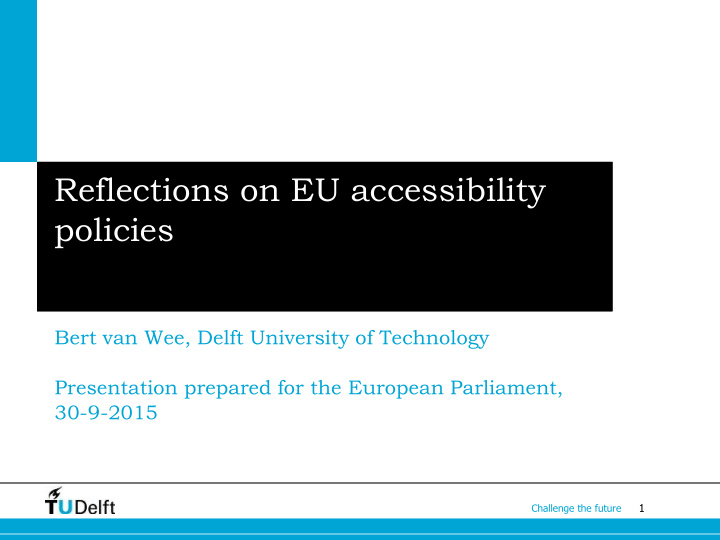



Reflections on EU accessibility policies Bert van Wee, Delft University of Technology Presentation prepared for the European Parliament, 30-9-2015 1 Challenge the future
Many positive aspects! • Definition – ease of reaching opportunities. So: Land use/activities/opportunities and transport system (and persons) (Geurs and van Wee, 2004), Hansen, 1959) • Also public transport, not only private • Spatial differences in accessibility 2 Challenge the future
• Link with social exclusion (Van Wee and Geurs, 2011; Lucas, van Wee and Maat, 2015) • Difference between accessibility and mobility • Potential tension between accessibility and liveability/environment 100 % Equal distribution line Cumulative share of accessibility Gini-index A ns Lorenz curve A s B X s Cumulative share of people 100 % from low to high level of accessibility 3 Challenge the future
• Importance of land-use planning and planning for sustainable modes • Important role of ICT (teleworking, e-shopping) and trip options (Van Wee, Chorus and Geurs, 2013) • Collaboration between travel providers • Travellers’ needs • New forms of mobility management 4 Challenge the future
Challenges 1. Limited attention to goods transport 2. How to evaluate (at least ex ante) accessiblity effects of candidate policy options 3. How to value such evaluations, and included them in evaluation frameworks like Cost-Benefit Analysis, Multi- Criteria analysis? 5 Challenge the future
Challenges 4. Perceptions of accessibility E.g.Quality of route between origin and destination, certainly for slow modes 6 Challenge the future
Subtitle How will the IT- revolution affect the users’ travel behaviour? Substitution, complementarity. Net effect: zero (or small increase), but still many effects ICT as a pain killer: thanks to ICT we are less vulnerable for disruptions in the transport system (Van Wee, 2011) 7 Challenge the future
Infrastructure Transport component technologies Reduce resistance Mobile devices Land-use component Land-use changes PC use at Match actors-locations fixed locations Match actors-destinations Temporal component Availability of opportunities by time Time available for activities Individual component Needs and wants Abilities Opportunities Social networks Household interactions 8 Challenge the future
Which is the role of sharing economy and of mobility as a service ? • Poorly understood – hardly any literature • Important question • Importance of generations (cohorts), not only age • High potential also in rural areas, reduce social exclusion 9 Challenge the future
What is the role of the urban planners, are they in the front or the back seat? What is the role of JPI Urban Europe? • Planners: should be in the front seat • But: planning not only for accessibility • Land use and transport planners: different cultures / traditions 10 Challenge the future
Subtitle 11 Challenge the future
Subtitle 12 Challenge the future
Recommend
More recommend